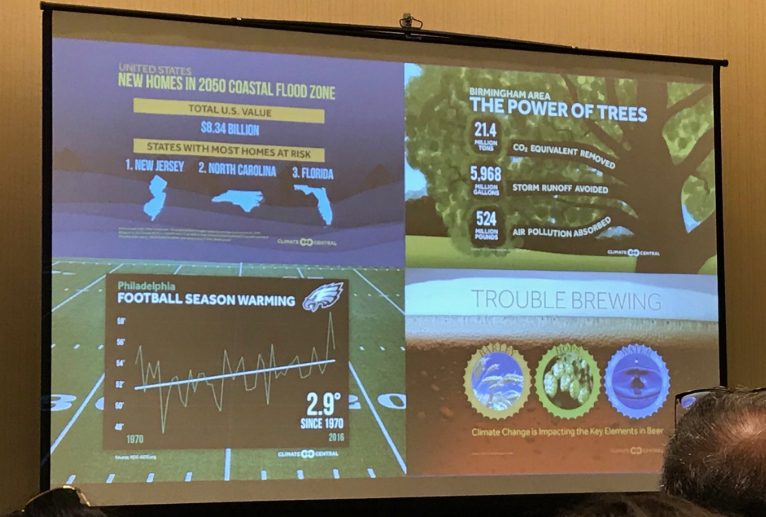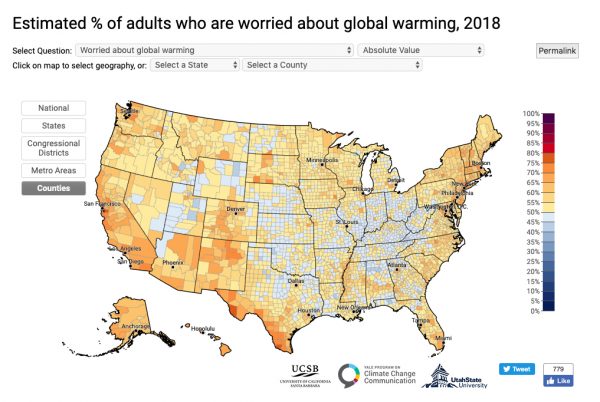
Climate change is “planet-size.” But local audiences are increasingly hungry for coverage that connects those global trends to what’s happening in their own backyard. Early successes by a few local innovators point to the opportunity for local news stations to be the go-to source for climate coverage in their communities.
The Data
Opinion data collected by Yale University tracks change in public sentiment regarding global warming. At September’s Excellence in Journalism conference in San Antonio, Ed Maibach of George Mason University’s Center for Climate Change Communication presented data showing a strong shift in the past five years toward increased concern – and less skepticism – about climate change and its effects. The interactive Climate Opinion Map is a tool that enables any local news organization to drill down to see climate survey results at a hyper-local level for its community, an insightful tool for planning coverage.
Audience Engagement
Research released in August 2019 by Chartbeat shows that news organizations are increasing their climate coverage, and climate stories are generating higher engagement from audiences. Comparing the first quarter of 2019 to similar periods in the past two years, the number of climate stories published was up 27% and 56% respectively from 2017 and 2018. Impressively, the time spent with those articles was up even more: up 52% from 2017 and up 80% from 2018. If it was ever true that climate stories were a ratings killer in the past, the data show the opposite now.

Local Meteorologists as Climate Storytellers
In January, I contributed to the Nieman Lab’s annual predictions for the ‘year in journalism’ by penning a piece advocating that this could – and should – be the year that local news stations use their best graphics, best scientist and most trusted personalities – their weather anchors – to localize the story of climate.
At EIJ, WRC-TV News Director Mike Goldrick cited that article as part of the inspiration for WRC’s station-wide, multi-month local initiative called “Changing Climate.” Goldrick noted the coverage wasn’t just important content, but it performed well with the audience on all the key metrics.
Impressive Case Study from @gatormikenews on how WRC-TV tackled climate change as a local news story – and the strong Audience Engagement that resulted. #climatematters #EIJ19 pic.twitter.com/0TXNJUMDtT
— Frank Mungeam (@frankwords) September 5, 2019
Local climate stories by NBC4 include a report on rising local temperatures; the reasons why east coast hurricanes are becoming more intense; and a report explaining why leaves are turning brown sooner in the fall in Virginia.
WRC is not alone. Two local forecasters, Amber Sullins at ABC15 in Phoenix and Mike Nelson at the DenverChannel in Denver, earned shout-outs recently via The Takeaway podcast for regularly incorporating climate change information as part of their weather reporting. We profiled Sullins’ climate coverage in our Cronkite News Lab Social Media Spotlight.
No less than the UK Guardian published an article in mid-September headlined: How TV Weathercasters Became the Unsung Heroes of the Climate Crisis, highlighting the reporting of meteorologists at various local TV stations in the U.S.
Here at the ASU Cronkite School of Journalism, we’ve also been experimenting with ways to localize the climate change story and for ways to incorporate more compelling augmented reality visualizations. Here’s Cronkite News lead weather anchor Jordan Evans’ story showing how global warming trends apply to Arizona’s most populous urban areas and most popular national parks.
ICYMI: Yesterday, I talked how climate change is affecting us right here in Arizona. Major cities are not the only ones feeling the effects of warming, but so are national parks. Thanks again, @ClimateCentral for this data! @cronkitenews #azwx pic.twitter.com/Dx6XY8S1k6
— Jordan Evans (@jordanevanswx) September 19, 2019
For stations looking to increase and improve their local coverage of climate, Climate Central is a robust resource. The nonprofit and nonpartisan organization employs its own meteorologists and uses NOAA weather data to create relevant local visualizations that are free to use for local newsrooms. Some of the most popular visualizations created by Climate Central were shared at the EIJ conference. No shock, the top two were about beer and football.

Bernadette Woods Placky of Climate Central offers these best practices for newsrooms:
- Focus on the science
- Localize wherever possible
- Make it simple and compelling
- Tie in to the news cycle of what’s happening
Climate Central also maintains a robust web site that includes resources on potential story localizations as well as an ongoing archive of best practices from other local newsrooms.
You know the tide is turning on climate reporting when Variety magazine weighs in. A September article touted that even the major TV news networks are investing in more climate coverage. But local broadcasters are uniquely qualified and positioned to be the authority in the communities they serve for informing and empowering their audiences about climate change.
An earlier version of this story incorrectly identified Denver meteorologist Mike Nelson.
Get the Lab Report: The most important stories delivered to your inbox
